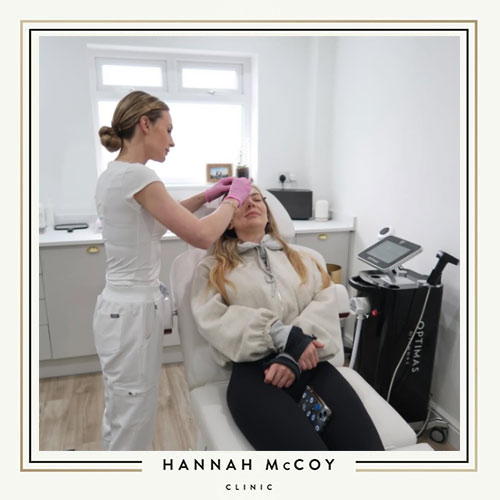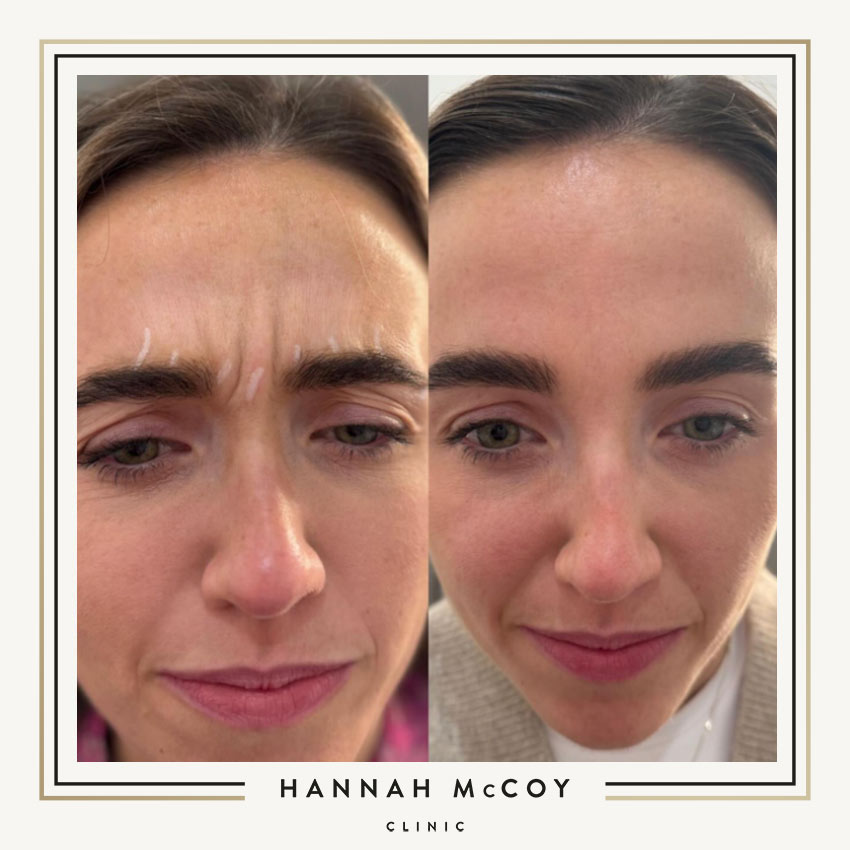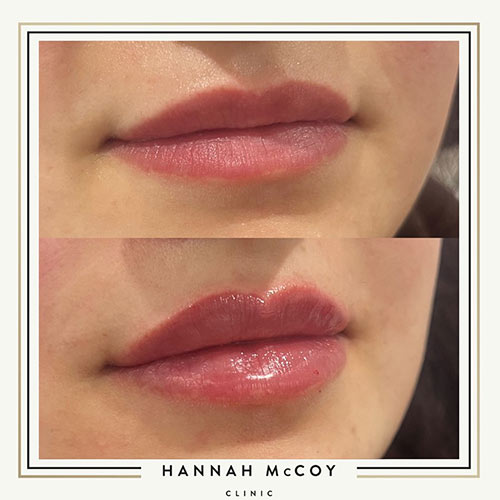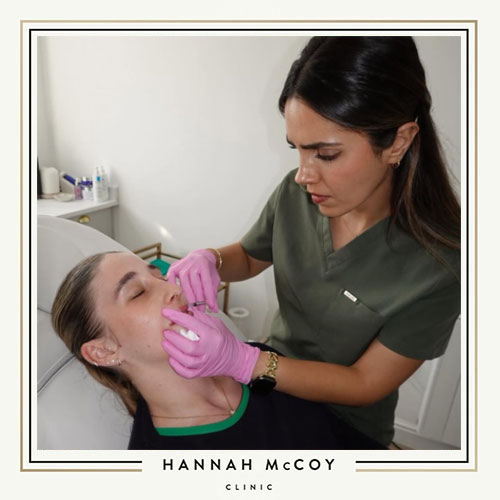BOTOX VS FILLERS: WHICH ONE IS BETTER?
Botox and dermal fillers are both powerful non-surgical aesthetic injectable treatments. Both can effectively reduce signs of ageing and enhance your natural features, but they work in different ways. So, which one should you choose?
This guide explains the difference between botox and dermal fillers, what each treatment is used for, their side effects, costs, and how to decide which is best for you. Keep on reading to learn more!
Table Of Contents
- Botox vs Fillers: A Quick Comparison
- Botox Treatment
- Dermal Fillers
- What Is the Difference Between Botox and Fillers?
- Can Botox and Fillers Be Used Together?
- Book Botox and Fillers at Hannah McCoy Clinic
- Botox vs Filler FAQs
Botox vs Fillers: A Quick Comparison
Before we get into the details, here’s a quick breakdown:
| Feature | Botox | Dermal Fillers |
|---|---|---|
| Main purpose | Relaxes muscles to smooth wrinkles | Adds volume, restores structure, enhances features |
| Best for | Dynamic wrinkles (caused by movement), such as forehead lines, crow’s feet, frown lines | Static lines, volume loss, lip enhancement, cheek lift, contouring |
| Results visible | 3–14 days after treatment | Immediately, with the final results after 1–2 weeks |
| Duration | Around 3–4 months | Around 6–12 months (depending on area and product) |
| Treatment areas | Forehead, eyes, frown lines, masseter, neck | Cheeks, lips, nasolabial folds, chin, jawline, nose, under-eye |
| Cost at Hannah McCoy Clinic | From £170 | From £175 |
| Pain level | Mild pinprick feeling, numbing available | Mild stinging or pressure, numbing available |
| Side effects | Redness, swelling, bruising, temporary headache | Swelling, bruising, tenderness, and very rare vascular issues |
| Reversible | Effects naturally fade | Hyaluronic acid fillers can be dissolved with hyaluronidase |
Botox Treatment
What Is Botox?
Botox, known by its brand name Botox®, is a purified protein derived from botulinum toxin type A. In aesthetics, it is used in very small, safe doses to temporarily relax facial muscles. This softens existing wrinkles and prevents new ones from forming.
How Does Botox Work?
When injected into a targeted area, botox blocks the nerve signals that cause muscle contractions. Without these contractions, the skin above the muscle appears smoother and more relaxed.
What Does Botox Treat?
Botox is best known for reducing lines and wrinkles, but it also has medical uses. Common treatments include:
- Forehead lines
- Frown lines (between the eyebrows)
- Crow’s feet around the eyes
- Bunny lines on the nose
- Platysmal bands in the neck
- Masseter muscle tension for teeth grinding or jaw clenching
- Excessive sweating (hyperhidrosis)
- Chronic migraines and headaches
What Areas Can Botox Treat?
Botox can be used across the face and neck, including:
- Upper face - forehead, frown lines, crow’s feet
- Mid face - bunny lines, nose, masseter
- Lower face - chin dimpling, jawline slimming
- Neck - platysmal bands

Is Botox Permanent?
No, botox is temporary and results last around three to four months. It varies from person to person, but you will notice when it’s wearing off as your muscle movement gradually returns.
What Are Botox Side Effects?
Most side effects of botox are minor and settle quickly. They may include:
- Swelling or redness at the injection site
- Bruising
- Mild headache
- Temporary drooping in rare cases
Learn more in our lip filler aftercare blog.
Is Botox Painful?
Botox injections feel like a quick pinprick. Most clients describe them as mildly uncomfortable rather than painful. If needed, a numbing cream can be applied to ease the discomfort.
How Much Does Botox Cost?
At Hannah McCoy Clinic, our botox treatments start from £170. The final cost will depend on the number of areas you choose to treat and the type of products used. If you’re interested in multiple treatments and would like to spread out the costs, check out our convenient finance plans.
Best Age to Start Botox
There is no single best age to start botox. Some people start in their late 20s to prevent wrinkles from forming, while others wait until their 30s or 40s to soften lines that are already visible. Using botox as a preventative method is very common, but it's also effective at smoothing out more prominent wrinkles.
What to Expect After Botox
After botox treatment:
- Results appear gradually within 3 to 14 days
- You may experience mild swelling or redness for a few hours
- Avoid lying flat, exercising, alcohol, and saunas for 24 hours
- Final results last three to four months before a top-up is needed

Dermal Fillers
What Are Dermal Fillers?
Dermal fillers are injectable gels made from hyaluronic acid (HA), a substance that naturally occurs in the body. Fillers restore lost volume, define features, and smooth deeper wrinkles. Unlike botox, fillers do not affect muscle movement.
How Do Dermal Fillers Work?
Dermal fillers use hyaluronic acid, a substance naturally found in the skin, to restore lost volume and hydration. Hyaluronic acid attracts and binds water molecules, creating a natural plumping effect. When injected into precise areas, dermal fillers can:
- Smooth out fine lines and wrinkles
- Add definition and contour to facial features
- Lift and firm sagging skin
- Enhance overall balance and symmetry
- Hydrate and volumise the lips
This makes them one of the most popular non-surgical treatments for facial rejuvenation.
What Areas Can You Get Dermal Fillers?
Dermal fillers are versatile and can be used across multiple facial areas to enhance and refresh your natural appearance. Common treatment areas include:
- Cheeks – for volume and lift
- Nasolabial folds (smile lines) – to soften deep creases
- Marionette lines – to reduce shadows around the mouth
- Lips – for fuller shape and hydration
- Lip lines (smoker’s lines) – to smooth vertical wrinkles
- Jawline – for sharper definition
- Chin for reshaping and balance
- Jowls or sagging skin – for a subtle lifting effect
- Non-surgical nose reshaping – to smooth bumps or refine shape
- Non-surgical facelift – for overall lift and rejuvenation
What Do Dermal Fillers Treat?
Dermal fillers can address a wide range of concerns, such as:
- Loss of volume in the cheeks, lips, and temples
- Facial asymmetry or lack of definition
- Fine lines around the lips and mouth
- Marionette lines
- Nasolabial folds
- Sagging, jowls, or hollow areas that make the face look tired
- Lack of hydration in the lips
Types of Dermal Filler
At Hannah McCoy Clinic, we only use high-quality, regulated dermal fillers to ensure safe treatments and natural-looking results. Different brands of filler are designed for specific purposes, and some of the most popular types include:
Teoxane RHA4
Teoxane RHA4 is part of the Resilient Hyaluronic Acid (RHA) collection. It is specifically designed for treating deeper wrinkles and restoring volume in areas such as the cheeks, jawline, and temples. Thanks to its flexible formula, it adapts well to facial movement to help you achieve natural results that last.
Juvederm
Juvederm is one of the most well-known dermal filler brands and is trusted worldwide for its safety and effectiveness. It offers a wide range of formulations to suit different needs, including subtle lip enhancement and full facial contouring. Juvederm fillers are smooth in texture and contain lidocaine (a local anaesthetic), which makes treatment more comfortable.
Stylage
Stylage fillers are made with hyaluronic acid combined with antioxidants, which help to reduce post-treatment swelling and protect the skin against free radicals.
Stylage is versatile and can be used for lips, nasolabial folds, marionette lines, and restoring hydration in the skin. It is commonly chosen for gentle volume restoration and skin hydration, especially in delicate areas.
[Insert image of each type - if possible]
What Are Dermal Filler Side Effects?
Most dermal filler side effects are mild and temporary but include swelling, bruising and redness or tenderness at the injected area. In rare cases, more serious complications like infection or vascular occlusion can occur.
Choosing a qualified and experienced professional greatly reduces these risks.
Is Dermal Filler Painful?
Dermal filler treatments are generally well-tolerated. Most dermal fillers contain lidocaine, a built-in local anaesthetic which helps to minimise discomfort.
A numbing cream is usually applied beforehand as well. Clients often describe the sensation as mild pressure or a brief stinging feeling, rather than pain.
Are Dermal Fillers Permanent?
No, dermal fillers are not permanent. Results typically last 6 to 12 months, depending on the type of filler used, the treatment area, and individual metabolism.
Over time, the body naturally breaks down and absorbs the filler, which is why they are non-permanent and require maintenance top-ups.
How Much Do Dermal Fillers Cost?
At Hannah McCoy Clinic, fillers start from £175. Prices vary depending on whether you choose standard or premium filler, as well as the amount of product (ml) required for your treatment.
If you’re unsure how many you’ll need, add on a free consultation when booking your dermal filler treatment, and we can best advise you. You can choose from a same-day consultation or a different-day consultation if you’d like more time to decide.
What Is The Best Age to Start Dermal Fillers?
Dermal fillers can be used at different ages for different purposes. Younger clients may use them to enhance features such as lips or jawline, while older clients often choose fillers to replace lost volume or lift sagging areas.
If you’re unsure whether now is the right time for you to get dermal fillers, we’re here to help. Give us a call on 0151 332 3333, or text/WhatsApp us on 07539 422 873, and we’re happy to answer any questions regarding treatments.
What to Expect After Dermal Fillers
After your dermal filler treatment:
- Results are visible immediately, but may take 1–2 weeks to fully settle
- Temporary swelling, bruising and tenderness are common, but an ice pack can be applied within the first 12 hours to ease this (apply for 15 minutes every hour)
- Lips may feel firmer or slightly harder than before, but this will soften naturally as the filler integrates with the lip tissue
- Avoid heat, alcohol, and strenuous exercise for 24–48 hours
- Results typically last 6–12 months on average
Following the aftercare manual we provide will help to ensure your dermal filler settles without any complications or risk of infection. However, we are always available should you need us post-treatment.

What Is the Difference Between Botox and Fillers?
The difference between botox and fillers is that botox temporarily relaxes muscles to smooth wrinkles caused by facial movement, while dermal fillers are used to add volume and structure to areas that have lost fullness or need contouring. Although they are similar, they are different.
Botox is best for dynamic lines such as forehead wrinkles and crow’s feet, whereas fillers are ideal for plumping lips, lifting cheeks, and softening deep static lines to restore or enhance natural facial features.
Is Botox or Filler Better?
Neither treatment is universally “better”; it just depends on your specific goals. The best option will depend on your age, skin type, and desired outcome, which a qualified practitioner can recommend during a consultation.
In general:
- Choose botox if you want to smooth expression lines and prevent them from deepening
- Choose dermal fillers if you want to add volume, enhance facial features, or soften deeper folds
Can Botox and Fillers Be Used Together?
Absolutely! Botox and fillers complement each other and are often used together in a treatment plan. For example, botox may be used in the forehead to soften lines, while fillers add volume to the cheeks or lips.
This combination addresses both wrinkles and volume loss for a natural and renewed look.
Book Botox and Fillers at Hannah McCoy Clinic
Not sure if Botox, fillers, or a combination is right for you? Our expert Medical Aesthetics Practitioners will guide you through every step and help you choose the perfect treatment for your needs.
At our flagship Liverpool clinic, as well as our trusted partner locations in Leeds, London, and the Isle of Man, you’ll receive personalised care, tailored treatment plans, and results designed to match your goals.
With thousands of happy clients and a 5-star Google rating, you can feel confident you’re in the best hands, whether that be for Botox, Dermal Fillers, Chemical Peels, Microneedling, Morpheus8, Lumecca or Mesotheraphy.
Ready to look refreshed and feel amazing? Book your consultation today and let’s make it happen.
Botox vs Filler FAQs
1) Is botox or filler better for forehead lines?
Botox is usually more effective for forehead lines because they are caused by repeated muscle movement.
2) How long do botox and fillers last?
Botox lasts three to four months. Dermal fillers last six to twelve months, depending on the area and product. Learn more here.
3) What is the difference between jawline filler and masseter botox?
Jawline filler adds definition and structure, while masseter Botox slims the face by relaxing enlarged jaw muscles.

